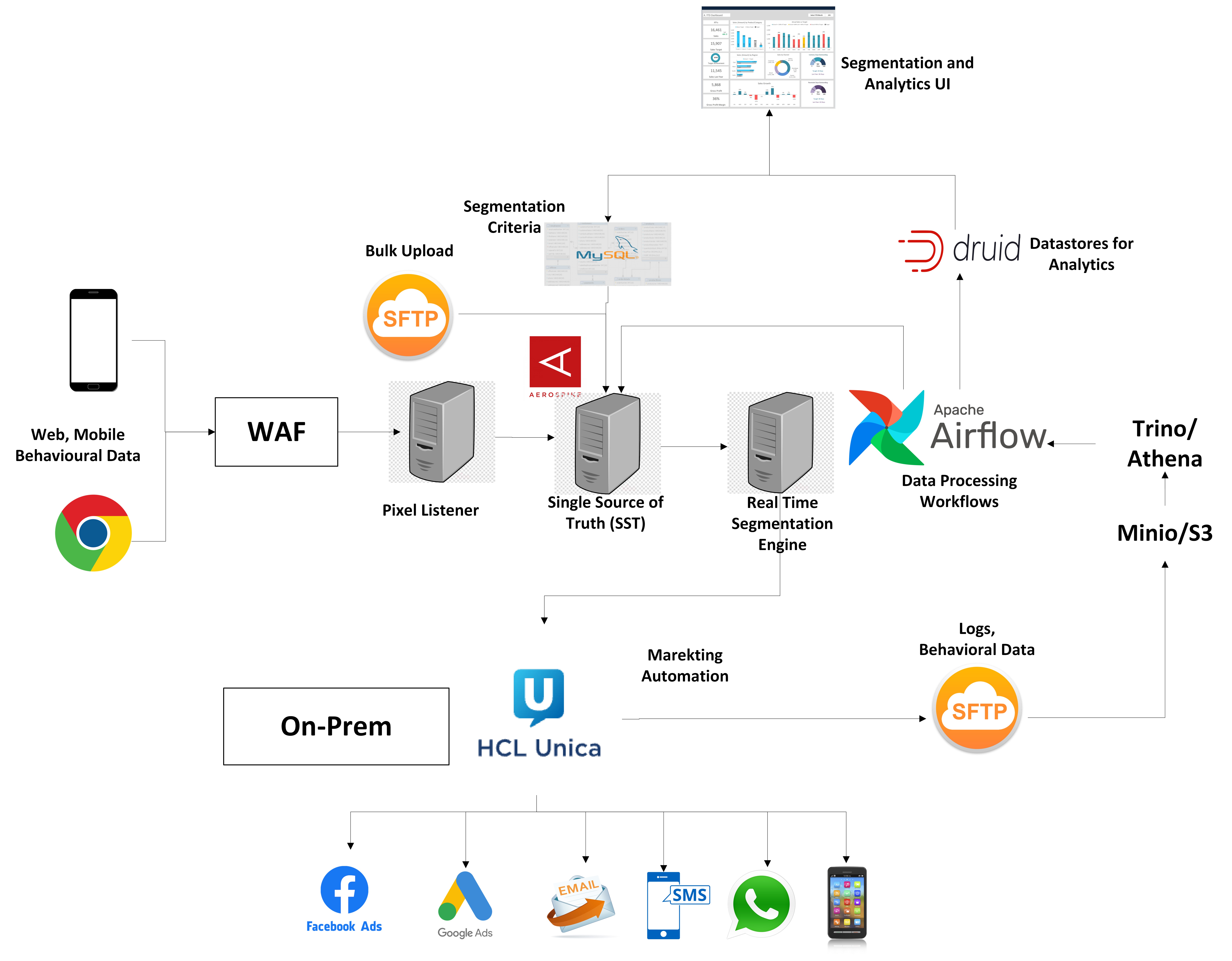HCL CDP Architecture
HCL CDP is intended to gather, process, and analyze behavioral data from web and mobile platforms for marketing objectives. It incorporates various systems to collect user data, which is then processed for segmentation, enabling the delivery of targeted marketing campaigns through multiple channels. The subsequent sections outline the essential components and their interactions in a streamlined flow.

Data Collection and Security
The process initiates with the gathering of behavioral data from web browsers and mobile applications. Each user interaction on a website or mobile app, including clicks and navigation, is recorded by a pixel tracking system. Before the data is stored or processed, it is filtered through a security mechanism referred to as a Web Application Firewall (WAF). This firewall ensures the safety of all incoming data, effectively mitigating potential security threats and unauthorized access to the system.
Data Storage and Real-Time Processing
Once the data has been securely gathered, it is transmitted to the system's core, referred to as the Single Source of Truth (SST). This central component guarantees that all information regarding a user, whether sourced from the web or a mobile application, is stored consistently, thereby offering a cohesive perspective on each user's behavior.
To interpret this data and take appropriate actions, a real-time segmentation engine analyzes user information according to established rules or behavioral patterns. This functionality enables the system to categorize users into various segments based on their interactions. For instance, users who regularly visit a specific product page may be classified into a "high interest" segment.
Data Processing and Orchestration
Data requires processing and transformation for a variety of applications, including analytics and reporting. This is where the orchestration platform, Apache Airflow, plays a crucial role. Airflow automates data processing, ensuring that tasks such as data aggregation, segmentation, and analysis are executed seamlessly and timely. Concurrently, the system utilizes MinIO, a high-performance object storage service, to retain logs and raw data for future use.
Additionally, advanced query engines like Trino and analytics platforms such as Druid are utilized to effectively store and query large volumes of data, facilitating the real-time extraction of insights regarding user behavior.
User Interface and Analytics
The system presents all collected and processed data to end users via an intuitive interface. This segmentation and analytics user interface enables marketers and business professionals to examine the data, formulate new segmentation rules, or modify existing ones according to their organizational requirements. Through this interface, users can effortlessly monitor user activity, comprehend behavioral patterns, and establish new criteria for user segmentation.
Marketing Automation and Campaign Execution
Once users have been categorized according to their behavior, the system initiates marketing campaigns aimed at effectively reaching these segments. The marketing automation tool, HCL Unica, interfaces directly with the segmented data, guaranteeing that tailored marketing messages are dispatched to the appropriate users at optimal times. Whether it involves delivering advertisements on platforms such as Facebook or Google, or communicating via SMS, WhatsApp, or email, the system ensures that the marketing approach remains both timely and pertinent.
Once the rules are set and data is processed, the system autonomously executes campaigns, allowing marketers to conserve time and concentrate on strategic planning and analysis.
Integration with External Systems
The system further incorporates external data sources and marketing channels. For example, data can be transferred in bulk through secure file transfer protocols (SFTP) for subsequent analysis. Additionally, it facilitates integrations with prominent advertising platforms such as Facebook Ads and Google Ads, thereby optimizing marketing initiatives across various channels. This capability allows for a comprehensive strategy that utilizes both web and app user data for cross-channel marketing campaigns.